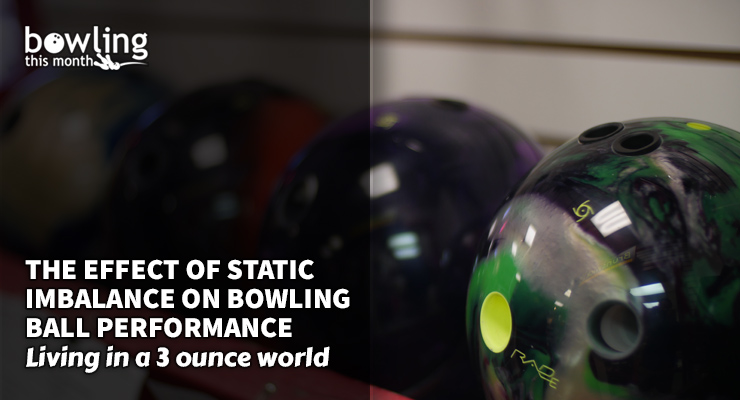Article Contents
- 1. What exactly is the effect of static imbalance?
- 2. The USBC’s recent static imbalance study
- 2.1. Static weights and launch angle variation?
- 3. Some extremely important caveats
- 3.1. It matters when the ball enter the roll phase
- 3.2. It matters how the ball flares
- 3.3. A change in side weight is not exactly the same as a change in drilling angle
- 4. But what about the Brunswick CG video?
- 5. Practical implications
- 5.1. Bowler style considerations
- 5.2. Other considerations
- 6. Closing thoughts
- 7. References
Note: This article is only available to Bowling This Month subscribers.
As many of you are likely already aware, the USBC recently announced that they will be implementing some new equipment specifications rule changes in the very near future that will affect how bowling balls can be drilled. You can read what they had to say about these changes in their official press releases (available here1 and here2), but here is a quick summary of the new drilling-related specifications:
- All balance holes are soon to become illegal (effective August 1, 2020). Bowling balls with existing balance holes can only be used after that date if the hole has been plugged.
- The static imbalance limits for side weight and finger/thumb weight will be loosened from the current limit of ±1 ounce to ±3 ounces. The current top/bottom weight limit of ±3 ounces remains unchanged. These new limits go in place August 1, 2018 for balls that do not have balance holes. From August 1, 2018 until July 31, 2020, balls that do have balance holes must follow the ±1 ounce limits for side weight and finger/thumb weight. This essentially provides a two-year “phasing in” period, during which time bowlers can either choose to use a balance hole and follow the old static imbalance limits, or use no balance hole and follow the new static imbalance limits.
If you read my last article—which was published shortly after the release of the USBC’s Bowling Technology Study and before these rule changes were officially adopted—you should already know that I’m no fan of these rule changes. To summarize that article, I don’t believe that eliminating balance holes will do anything to significantly reduce the performance of modern high-flaring bowling balls, but I do believe that—in some circumstances—the enlarged static imbalance ranges can be used to increase the bowling ball’s performance. For those reasons, I just don’t see the point of disrupting the entire bowling industry with these changes.
But, barring some last-minute moment of enlightenment that causes the USBC to change its mind, these rules changes are unfortunately coming, and it seems that there’s nothing any of us can do to stop them. So, as bowlers, as pro shop operators, and as coaches, we all need to make sure we understand them so that we can properly prepare. To that end, the focus of this article is on the effect of static imbalance and the implications of the new ±3 ounce limits. I’ll cover the balance hole elimination rule in a follow-up article in the near future.
My intent with these articles is to give practical suggestions on how to approach ball drilling under the new rules. But, we really can’t get to the practical stuff until after laying some technical groundwork. And, what better place to start than with the debate that’s raged on for decades in the bowling industry…
What exactly is the effect of static imbalance?
For years now, I’ve resisted the impulse to write about this topic, primarily for the reason that it’s just so incredibly divisive. No matter what I say, some percentage of you will walk away from this thinking that I’m an idiot who doesn’t know what he’s talking about.
Many well-intentioned people have weighed in on this topic over the years—running tests, producing videos, writing research reports, etc.—attempting to show how significant or insignificant static imbalance is in the modern game. While there is quite a bit of information out there, there still doesn’t appear to be a universal consensus. The tendency I see time and time again is for people to cherry-pick their favorite example—typically the one that best matches their view on this topic—and attempt to present it as definitive proof that they are right and that the opposing viewpoint is wrong. It would be great if things were actually so simple, but, unfortunately, they just aren’t.
So, what exactly is the effect of static imbalance? We’re going to examine this question in detail below, but—in case you can’t wait—the bottom line is this: it depends! In some situations, static imbalance is a significant factor in the performance of the ball. In other situations, it isn’t really all that significant. In my opinion, this is definitely one of the things that can make it so confusing.
Let’s start our analysis by looking at one recent example of a static imbalance study that was conducted by the USBC’s Equipment Specifications team.
The USBC’s recent static imbalance study
This experiment was done as a follow-up to the USBC’s Bowling Technology Study, with the results published here3. Its purpose ...
Already a premium member? Click here to log in.


